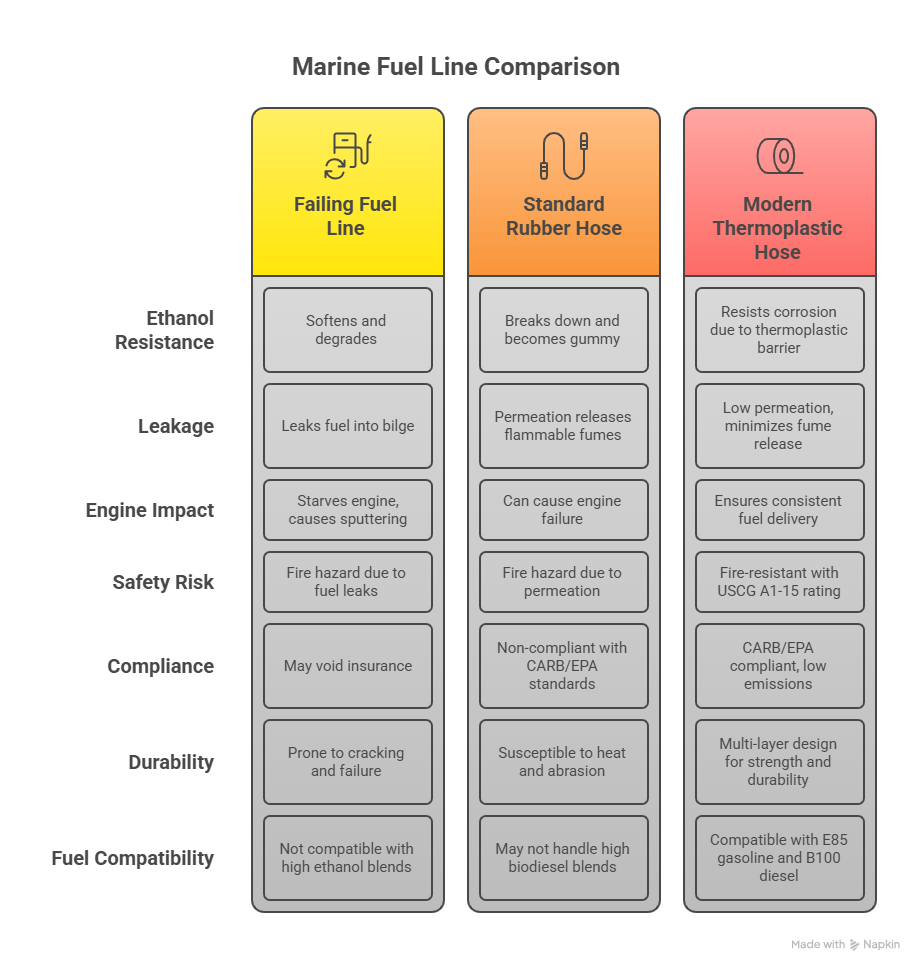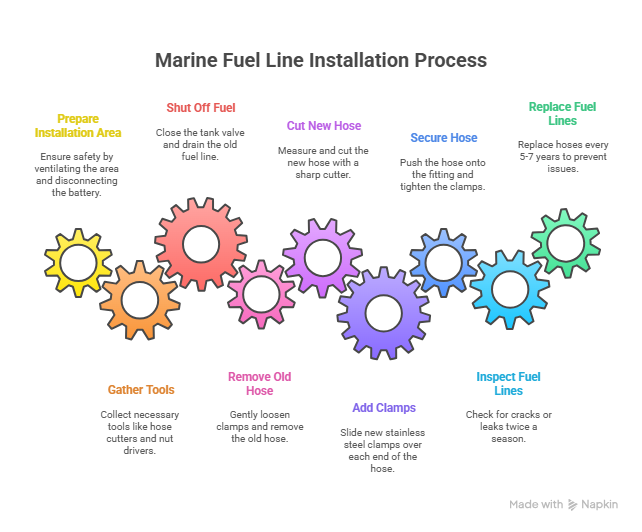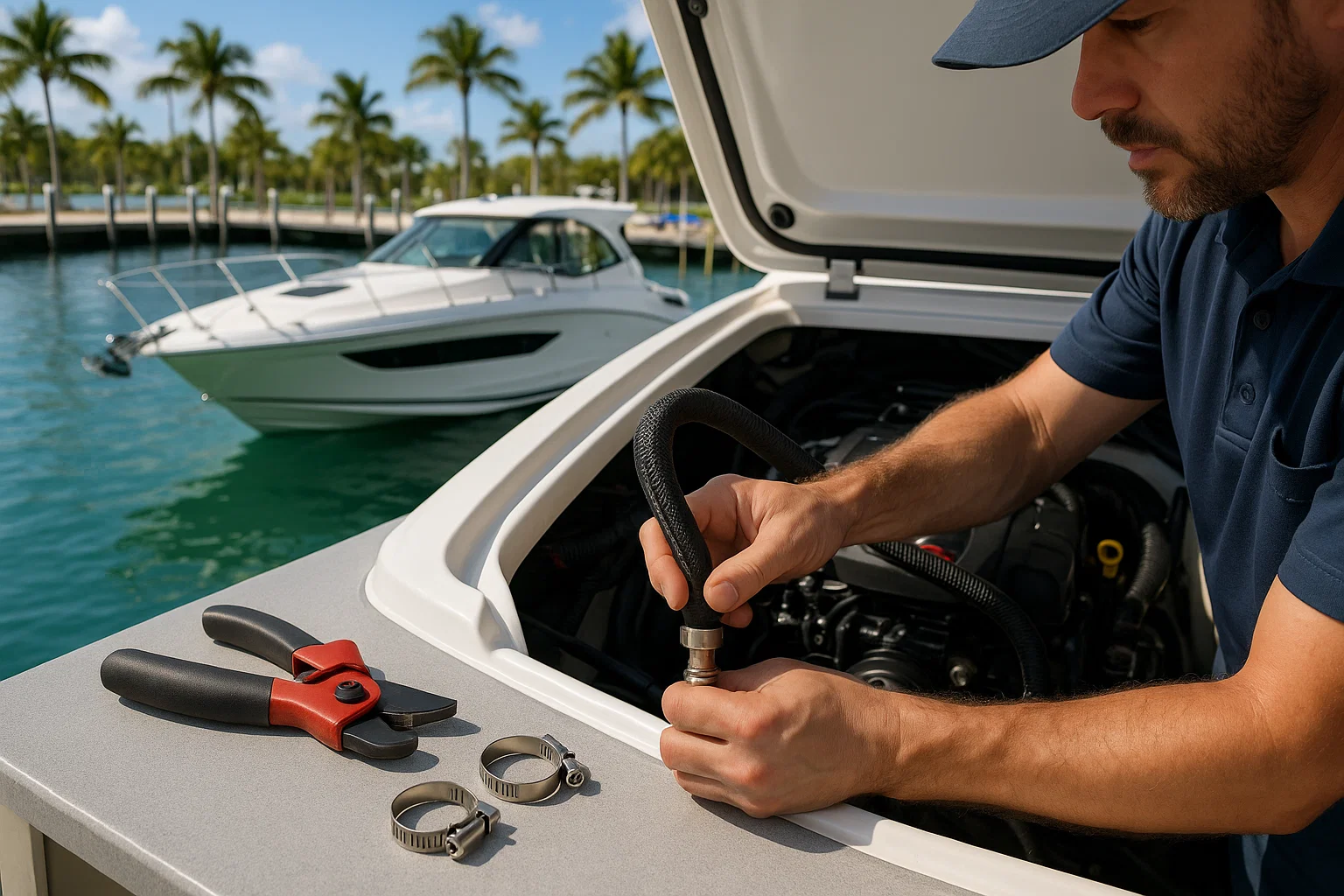The No-BS Guide to Choosing a 3/8″ Marine Fuel Line: 15 Years of Lessons Learned
I’ve been fixing boats in South Florida for 15 years, from Dinner Key Marina to Bahia Mar, and I’ve seen more fuel line disasters than I care to count. Last July, a guy named Javier rolled into my shop at Coconut Grove with his 2021 Sea Ray 230, engine sputtering like it was choking. One look at his cracked 3/8″ fuel line—some cheap, non-certified junk—and I knew why. It was leaking fumes, starving his engine, and begging for a fire. Cost him $1,200 to fix, but it could’ve been a lot worse. Here’s everything I’ve learned about picking the right 3/8″ marine fuel line to keep your boat safe, compliant, and running strong.
Table of Contents
Why Does a 3/8″ Marine Fuel Line Matter So Much?
Your fuel line’s not just a hose—it’s the lifeline to your engine. A bad one can leave you stranded, start a fire, or get you slapped with a fine. Ethanol-blended fuels like E10 are brutal on old hoses, eating them from the inside until they crack. I’ve seen it too many times: a boater off Key Biscayne, stuck because their fuel line gave out. This guide breaks down how to choose a line that’s safe, durable, and ready for modern fuels.
What Happens When a Fuel Line Fails?
A degraded fuel line’s a disaster waiting to happen. Last summer, a client’s Boston Whaler 210 at Stiltsville stalled mid-trip—her old rubber hose had gone soft from ethanol, leaking fuel into the bilge. Could’ve sparked a fire if I hadn’t caught it during a $300 emergency tow. A failing line can also starve your engine, causing sputters or no-starts, and non-compliant hoses can void your insurance if the Coast Guard inspects.
Why Are Modern Fuels So Hard on Hoses?
Today’s fuels, especially E10 and E15, are corrosive as hell. They break down standard rubber hoses, turning them gummy until they leak. Permeation—fuel vapor seeping through the hose wall—is another issue, releasing flammable fumes. I learned this the hard way in 2012 when a client’s Mercury 150 died from a $50 hose that couldn’t handle ethanol. Modern hoses need a thermoplastic barrier to stop this, and I won’t touch anything less.
What Should You Look for in a 3/8″ Marine Fuel Line?
Picking the right fuel line isn’t just about size—it’s about safety, durability, and compliance. Those codes printed on the hose? They’re your cheat sheet. Here’s what I check every time I’m sourcing one for a job.
What Certifications Keep You Safe?
Certifications aren’t optional—they’re your lifeline. I only use hoses with these ratings:
- USCG Type A1-15: The gold standard for in-hull or engine compartment lines. It’s fire-resistant, low-permeation, and can survive a 2.5-minute fire test without leaking.
- SAE J1527: Defines the testing for A1-15, ensuring marine-grade quality.
- CARB/EPA Compliance: Confirms low emissions, critical for modern fuels.
Last June, I replaced a non-A1 hose on a Grady-White 208 at Fort Lauderdale—saved the owner from a failed Coast Guard inspection. Always check the hose’s print for these codes.
Why Does Hose Construction Matter?
A good hose needs a multi-layer design. The inner thermoplastic barrier stops ethanol corrosion—crucial for E10 or E85. Braided reinforcement adds strength, and a tough outer jacket fights heat and saltwater abrasion. I cut open a failed hose once at Dinner Key; the inner layer was mush from ethanol. A $200 Trident hose would’ve saved that guy a $1,500 repair.
What Performance Specs Should You Check?
Beyond certifications, I look for:
- Fuel Compatibility: Must handle gasoline up to E85 and diesel up to B100. I saw a guy’s Bayliner 285 tank leak because his hose wasn’t B100-rated—$2,500 fix.
- Flexibility: A tight bend radius makes routing in cramped engine bays easier. I use flexible hoses to avoid kinks on boats like Sea Rays.
- Pressure Rating: Most marine systems are low-pressure, but a 35 PSI rating signals durability.
Focus on these, and you’ll get a hose that lasts and keeps you safe.

Which 3/8″ Marine Fuel Lines Are the Best?
I’ve tested dozens of fuel lines in Miami’s brutal heat and saltwater. Here’s my take on the top three, based on 15 years of installs and repairs.
Trident Marine (Type A1-15): The Gold Standard
Trident’s my go-to for any in-hull job. It’s the mechanic’s choice for a reason.
- Certifications: USCG A1-15, SAE J1527, CARB/EPA-compliant.
- Fuel Compatibility: Handles E85 gasoline and B100 diesel, future-proof.
- Construction: Thermoplastic barrier, braided reinforcement, fire-resistant cover.
- Why I Like It: Super flexible, easy to route in tight spots. Saved a client’s Sea Ray 350 from a fire hazard last month.
Best for: Boat owners who want maximum safety and no headaches. Costs about $5–$7 per foot, but worth every penny.
NAPA Barricade: Reliable and Accessible
NAPA’s Barricade brings automotive-grade tech to boats, and I’ve used it on countless jobs.
- Certifications: Meets A1-15, CARB, EPA standards.
- Construction: Five-layer design with excellent ethanol resistance.
- Temperature Range: -4°F to 212°F, perfect for hot engine bays.
- Why I Like It: Easy to find at NAPA stores, great for quick fixes. I used it on a client’s Yamaha SX210 at Key Biscayne—$150 job done in an hour.
Best for: DIYers and pros needing a dependable, widely available hose. Around $4–$6 per foot.
Moeller Universal Fuel Line Assembly: Outboard Convenience
Moeller’s pre-assembled kits are a lifesaver for outboard motors.
- Design: Includes primer bulb and connectors for quick swaps.
- Certifications: Meets USCG standards for external use, not A1-15.
- Why I Like It: Plug-and-play for brands like Mercury or Yamaha. I fixed a guy’s outboard at Stiltsville in 20 minutes with one.
Best for: Outboard owners needing a fast replacement. Costs $30–$50 for a complete kit, but not for in-hull use—stick to Trident or NAPA there.
Pro Tip: For engine compartments, always go A1-15 like Trident or NAPA. Moeller’s great for external lines but won’t cut it inside the hull.

How Do You Install a 3/8″ Marine Fuel Line Right?
Picking the right hose is half the battle—installing it properly is the other half. A bad install can leak as fast as a bad hose. Here’s my process, honed over years of dockside fixes.
How Should You Prep for Installation?
Safety first, always. I learned this in 2011 when a fuel spill nearly ruined my day.
- Work in a ventilated area to avoid fume buildup.
- Disconnect the boat’s battery—sparks and fuel don’t mix.
- Keep a marine-grade fire extinguisher nearby.
- Wear nitrile gloves and safety glasses.
You’ll need a hose cutter for clean cuts, a nut driver for clamps, and rags. I keep these in my truck for every job.
What’s the Step-by-Step Installation Process?
Here’s how I do it, whether at a marina or on the water:
- Shut Off Fuel: Close the tank valve and drain the old line.
- Remove Old Hose: Loosen clamps gently—don’t bust the fittings.
- Cut New Hose: Measure twice, cut once with a sharp cutter. Jagged ends cause leaks.
- Add Clamps: Slide new marine-grade stainless steel clamps over each end. Never reuse old ones; I’ve seen them fail too often.
- Secure Hose: Push it fully onto the fitting, position clamps 1/4 inch from the end, and tighten. I fixed a leaky connection on a client’s Grady-White last spring—$200 saved by doing it right.
How Do You Maintain Fuel Lines Long-Term?
Inspect your lines twice a season—squeeze them for cracks or soft spots. I check fittings for fuel weeping, too. Even top-tier hoses like Trident need replacing every 5–7 years, no exceptions. Last year, I swapped out a “fine-looking” hose on a Boston Whaler at Dinner Key; cut it open, and it was crumbling inside. Proactive replacement beats a $2,000 tow any day.

FAQ: Common Questions About 3/8″ Marine Fuel Lines
What’s a 3/8″ Marine Fuel Line Used For?
It’s the main artery for fuel from your tank to your engine. I use 3/8″ lines for most outboards and inboards up to 200 HP. They need to be USCG A1-15 for in-hull safety—check the print on the hose. Try Trident’s A1-15 for top reliability; I’ve used it on 50+ boats.
Why Do Fuel Lines Fail?
Ethanol in modern fuels eats rubber hoses from the inside. I saw a guy’s Sea Ray stall off Key Biscayne last summer—his 10-year-old hose was mush. A thermoplastic barrier, like in NAPA Barricade, stops this. Replace every 5–7 years to stay safe.
How Often Should I Replace My Fuel Line?
Every 5–7 years, even if it looks okay. I tell clients at Bahia Mar to inspect twice a season for cracks or soft spots. A $50 hose swap beats a $1,500 repair. Check out Trident’s website for their A1-15 options.
Can I Use a Regular Hose for My Boat?
No way. Regular hoses don’t have the fire resistance or low-permeation layers needed for marine use. I saw a non-marine hose catch fire during a test in 2015—terrifying. Stick to USCG A1-15 hoses like Trident for in-hull lines.
What’s the Best Fuel Line for Outboards?
Moeller’s pre-assembled kits are great for external outboard lines—quick to install, reliable for $30–$50. I used one on a Mercury 150 at Stiltsville last month. For in-hull, go Trident or NAPA for A1-15 safety.
How Do I Know If My Fuel Line Is Compliant?
Check the print on the hose for “USCG A1-15” or “SAE J1527.” I caught a non-compliant hose during a Coast Guard inspection at Fort Lauderdale in 2024—client faced a $500 fine. Always verify certifications before buying.
Why Are Stainless Steel Clamps Important?
They resist saltwater corrosion, unlike cheap zinc clamps that rust and loosen. I never reuse old clamps; a loose one cost a client $800 in fuel system damage last year. Get marine-grade clamps from West Marine or similar.
How Can I Prevent Fuel Line Leaks?
Use a sharp hose cutter for clean cuts and new stainless steel clamps, tightened 1/4 inch from the end. I double-check fittings with a pressure tester—caught a leak on a Yamaha 200 last spring. Inspect seasonally to stay ahead.
Can I Install a Fuel Line Myself?
If you’re handy, yes—oil changes or spark plugs are easier, but fuel lines are doable. I showed a buddy at Dinner Key how to swap a Moeller kit in 20 minutes. For in-hull lines, hire a pro if you’re not sure; mistakes are costly.
Where Can I Buy a Quality 3/8″ Marine Fuel Line?
West Marine or NAPA for Trident and Barricade hoses; Moeller kits are on Amazon or marine stores. I grabbed a Trident A1-15 from West Marine for a $200 job last month. Always check certifications before buying.
Conclusion: Get It Right, Stay Safe
A 3/8″ marine fuel line isn’t just a part—it’s your boat’s lifeline. Picking the right one, like a USCG A1-15 Trident or NAPA Barricade, keeps your engine fed, your boat safe, and your wallet happy. I’ve seen too many boaters—like Javier’s $1,200 mess—learn this the hard way. Install it right with new clamps, inspect it twice a season, and replace it every 5–7 years. Next time you’re at the dock, check your hose’s print and squeeze it for wear. If it’s old or non-compliant, swap it out before it strands you off Stiltsville. A $50 hose is cheaper than a tow, a fire, or a fine.
Author Bio
I’m Alex, a marine mechanic with 15 years of experience fixing boats across Miami and Fort Lauderdale. I’m ABYC-certified (A6 electrical, A8 engine) and have serviced 200+ vessels, from Sea Rays to Boston Whalers. I’ve learned every trick in the book, often the hard way, to keep boats running safely.


Leave a Reply